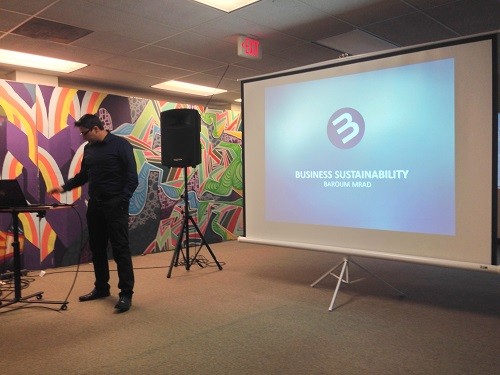Startup Sustainability Discussed at NJETS Meetup

The ebb and flow of the technology industry makes entrepreneurship in this sector both exciting and daunting. Few startups survive more than two to five years, and even fewer grow to be self-sustaining businesses.
One survival strategy is to consider how technology in your market is evolving and where that market will be in five years. A quote attributed to hockey legend Wayne Gretzky and frequently referenced by Apple CEO and founder Steve Jobs — “I skate to where the puck is going to be, not where it has been” — captures this mentality.
Addressing NJ Entrepreneurs and Technology Startups (NJETS) about business sustainability on May 20, 2014, was presenter Baroum Mrad, a marketing and communications specialist who has worked for New Jersey cloud and solutions provider SHI International (Somerset) and been a United Nations delegate on behalf of Switzerland. The meeting took place at JuiceTank (Somerset).
Mrad espoused the strategy that businesses consider where their industry will be in the next five years. “If you’re solving today’s problem, it might not necessarily be tomorrow’s problem,” he said, noting that companies have a habit of relying on the technology they are currently marketing to last them into the future.
Mrad said the kind of sustainability he was describing had nothing to do with corporate efforts to be more ecologically and socially responsible. He then described how businesses can survive beyond the average two- to five-year life of a startup.
What sustainability means to a startup is that you must be constantly iterating. “What this means is if you find a mistake or find your technology is taking you in another direction, that’s a good thing,” he said.
Mrad said an entrepreneur has to take on the dual roles of researcher and analyst. Entrepreneurs must stay on top of the news to learn about the latest developments in their market.
“What you realize is you have to find the trend and understand your business and look to where the trends are leading. …You look to see how lifestyles will change over that period of time,” advised Mrad.
Just as the UN considers how societies must reconfigure themselves according to the changing ecosystem, with its food and water shortages, so too must an entrepreneur consider the changing business ecosystem and how to adapt to it, he explained.
Specifically, app developers must consider the changing platform environment, Mrad said. He noted that after reading the news he has a sense that mobile devices have about five more years of growth before wearables become commonplace.
Mrad advised that tech entrepreneurs look to life sciences or biotechnology and nanotechnology as examples of where their business will be in the future. As an example, he pointed to a recent Google prototype of a contact lens with a camera in it.
“What does that tell you? A true sustainability analyst would see that augmented reality is the future … They would then ask their employees to at least look at the trends in augmented reality to see where it is going,” he noted.
Mrad said the most sustainable part of any company is not its product but its employees. For example, 10 years ago the iPod was Apple’s most ubiquitous product. Now that product is the iPhone (“Who uses an iPod anymore?” he asked). Apple employees, though, are known to stay on, making the firm one of the most sustainable companies today.

